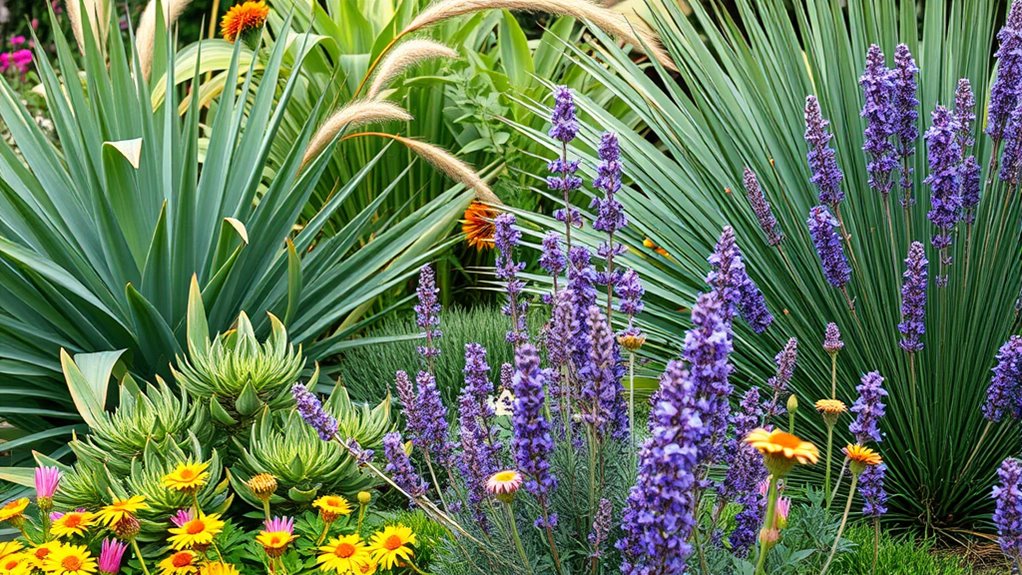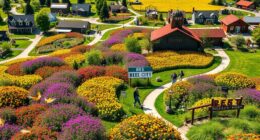I know how frustrating deer can be, so I recommend trying plants like yarrow, coneflowers, black-eyed Susans, and ornamental alliums, which are known for their resistance. Shrubs such as Nandina and fragrant lilacs also help add beauty without attracting deer. Choosing the right plants depends on your climate, soil, and garden style, but there are many options that combine beauty and deer resistance. If you stick around, you’ll discover even more effective plant choices for your garden.
Key Takeaways
- Choose native, deer-resistant plants like Black-Eyed Susan, Coneflower, and Yarrow to naturally deter deer.
- Incorporate fragrant, toxic, or bitter plants such as Allium and Ornamental Onion to discourage browsing.
- Use a mix of perennials, shrubs, and wildflowers suited to your climate and soil for long-lasting beauty.
- Combine deer-resistant plants with barriers and land shaping for enhanced garden protection.
- Select low-maintenance, drought-tolerant options like Shasta Daisy and Nandina for easy, resilient landscaping.
50 Deer-Resistant Plants: Beautiful Annuals, Perennials, Bulbs & Shrubs

If you’re looking to create a beautiful garden that stands up to deer browsing, “Deer-Resistant Plants” is an excellent resource for both novice and experienced gardeners. It introduces 50 plants, including annuals, perennials, bulbs, and shrubs, chosen for their resistance and beauty. The book offers detailed info on their soil and light needs, hardiness zones, and companion plants, helping you make informed choices. While no plant is entirely deer-proof, combining these with land shaping and barriers can markedly reduce damage. I’ve found this resource invaluable for planning landscapes that are both attractive and resilient against deer visits.
Best For: gardeners of all experience levels seeking practical, detailed guidance on planting deer-resistant, attractive landscapes.
Pros:
- Provides comprehensive information on 50 deer-resistant plants, including care and companion planting.
- Well-organized content with detailed descriptions that aid in planning and selection.
- Useful for both novice and seasoned gardeners aiming to reduce deer damage naturally.
Cons:
- No plant is entirely deer-proof, so ongoing management and barriers are still necessary.
- Regional plant availability may vary, limiting some plant choices depending on your location.
- The absence of on-page photos can make visual identification and planning less immediate.
Eden Brothers Deer Resistant Wildflower Mixed Seeds (1/4 lb)
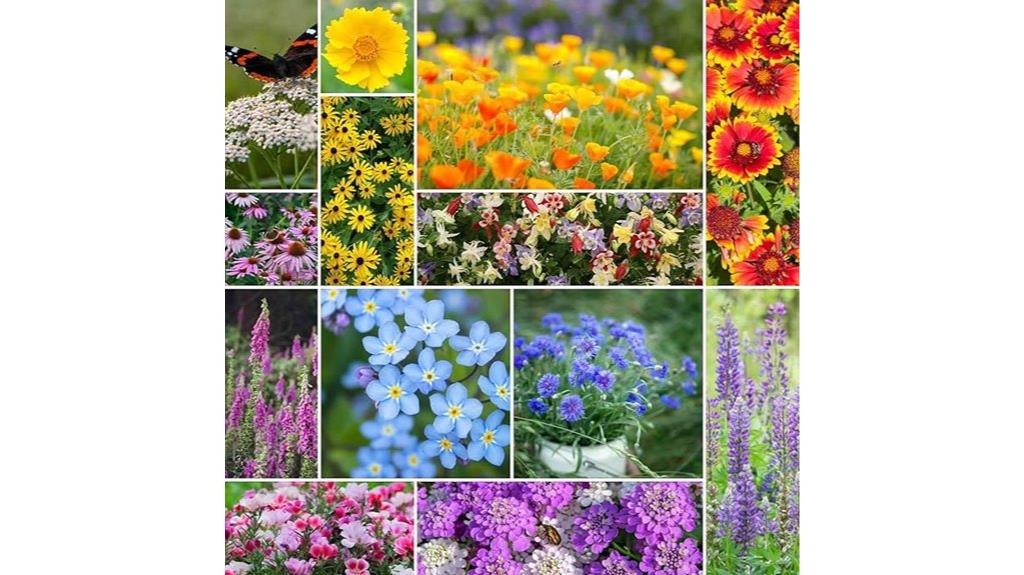
Looking for a low-maintenance way to add vibrant color to your garden while keeping deer at bay? Eden Brothers Deer Resistant Wildflower Mixed Seeds offer just that. This 1/4 lb mix includes 13 easy-to-grow species like Yarrow, Coneflower, and Black-Eyed Susan, which thrive in full sun or partial shade. With over 120,000 pure, non-GMO seeds, they’re designed for high germination and long-lasting blooms from spring to fall. These flowers attract pollinators and cover 250-500 square feet, boosting your garden’s biodiversity. Plus, they’re suitable for zones 3-10 and prefer sandy, well-drained soil. It’s a beautiful, eco-friendly solution to deer-proof gardening.
Best For: gardeners seeking a low-maintenance, deer-resistant wildflower mix that attracts pollinators and adds vibrant color to outdoor spaces in zones 3-10.
Pros:
- Includes 13 easy-to-grow, colorful species that bloom from spring to fall.
- Covers 250-500 square feet, making it cost-effective for larger garden areas.
- Attracts beneficial pollinators like bees, butterflies, and hummingbirds, supporting local ecosystems.
Cons:
- Germination rates and plant growth can vary depending on soil and planting conditions.
- Some species may produce burrs or grow taller than expected, requiring maintenance.
- Inconsistent performance reported by some users, with occasional limited variety or slow growth.
Deer-Resistant Mix Seed Packet

The Deer-Resistant Mix Seed Packet is an excellent choice for gardeners seeking to protect their landscape from deer damage while adding vibrant color. These mixes come in resealable pouches that keep seeds fresh, prevent mold, and extend shelf life, ensuring better germination. They include a variety of species that bloom at different times, providing continuous color and attracting pollinators like bees and butterflies. Adaptable to sun or shade and often drought-tolerant, these mixes are low-maintenance and perfect for beginners. Easy to plant with clear instructions, they help you create a lively, eco-friendly garden that’s both beautiful and deer-resistant.
Best For: gardeners looking to attract pollinators, add vibrant color, and protect their landscape from deer while maintaining a low-maintenance garden.
Pros:
- Resilient to deer, reducing damage to your plants
- Comes in resealable packaging that keeps seeds fresh and extends shelf life
- Attracts beneficial pollinators like bees, butterflies, and hummingbirds
Cons:
- May require some initial watering until established, especially in drought-prone areas
- Blooming times vary, so continuous color depends on proper planting and maintenance
- Not suitable for very shaded areas if some varieties prefer full sun
Outsidepride Blue Sage Seeds (5000 Pcs) for Pollinator Gardens

Outsidepride Blue Sage Seeds are an excellent choice for gardeners seeking deer-resistant plants that also support pollinators. With 5,000 seeds, they produce vibrant blue flowers from early summer through fall, attracting bees, butterflies, and hummingbirds. These drought-tolerant, low-maintenance seeds thrive in sunny, dry conditions and are suitable for wildflower meadows, borders, or open spaces. Growing 24–36 inches tall, they add color and texture to any landscape. Ideal for USDA zones 7–10, they’re easy to grow, germinate well, and require minimal watering once established. Plus, they’re GMO-free and environmentally friendly, making them a smart, attractive addition to your garden.
Best For: gardeners seeking low-maintenance, drought-tolerant plants that attract pollinators and enhance wildflower landscapes in USDA zones 7–10.
Pros:
- Supports pollinators such as bees, butterflies, and hummingbirds with vibrant nectar-rich flowers
- Drought-tolerant and low-maintenance, ideal for dry, sunny areas and xeriscaping
- Produces a large quantity of seeds (5,000) suitable for extensive planting and coverage
Cons:
- Some users experience inconsistent flowering or delayed blooming
- Requires full or partial sun for optimal growth; less suitable for shaded areas
- May have occasional germination variability despite generally high rates
Deer Resistant Wildflower Seed Mixture (1 Ounce Packet)

If you’re dealing with deer frequently browsing your garden, the Deer Resistant Wildflower Seed Mixture from Sweet Yards is an excellent choice. This 1-ounce packet contains over 15,000 high-germination seeds, enough to cover about 100 square feet with 22 various annual and perennial flowers. These flowers are designed to resist deer and even deter them from entering your planting area. They bloom from spring to fall, reaching up to 4 feet tall, and thrive in full sun with moderate watering. The seeds come in a resealable, attractive package with clear planting instructions, making it easy for both beginners and experienced gardeners to succeed.
Best For: gardeners in deer-populated areas seeking vibrant, easy-to-grow wildflowers that resist deer browsing and add color from spring to fall.
Pros:
- Contains over 15,000 high-germination seeds covering approximately 100 sq ft
- Includes 22 varieties of annual and perennial flowers designed to deter deer
- Packaged in an attractive, resealable container with clear planting instructions
Cons:
- Some customers have experienced less than ideal blooming or seed performance
- Seed size or quantity discrepancies reported by a few users
- May require moderate watering and full sun for optimal growth
Mixed Echinacea Sunseeker Salmon Flower Seeds for Planting
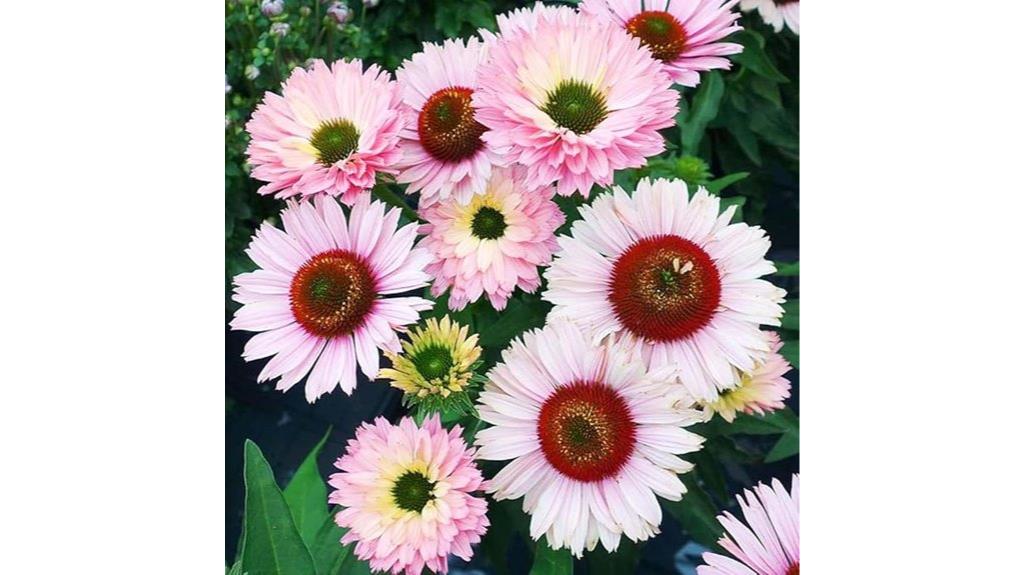
Gardeners seeking vibrant, deer-resistant plants will appreciate the Mixed Echinacea Sunseeker Salmon Flower Seeds for Planting. With over 1,000 seeds, you get a mix of colors like gold, red, orange, purple, yellow, and cream, creating a lively garden display. These tall, uniform plants reach about 27 inches and bloom throughout summer, thriving in full sun and sandy soil. Certified fire-resistant and adaptable to hot climates, they’re perfect for outdoor gardens, containers, or landscape beds. As a fragrant, perennial flower, Echinacea Sunseeker offers long-lasting beauty year after year. Keep in mind, germination success varies, so patience and proper planting techniques are key.
Best For: gardeners seeking a colorful, deer-resistant perennial with long-lasting blooms that thrive in hot climates and can be used in outdoor landscapes or containers.
Pros:
- Contains over 1,000 mixed seeds with vibrant colors like gold, red, orange, purple, yellow, and cream for a lively garden display
- Certified fire-resistant and heat-tolerant, suitable for hot climates like Texas summers
- Perennial and hardy to USDA zone 4, ensuring long-term growth and outdoor adaptability
Cons:
- Inconsistent germination success, with some customers experiencing poor or no sprouting
- Lack of detailed planting instructions may lead to difficulties in achieving optimal growth
- Variability in bloom timing and seedling development, requiring patience and experimentation
Ferry-Morse Deer Resistant Mix Bulk Wildflower Seeds, 1lb
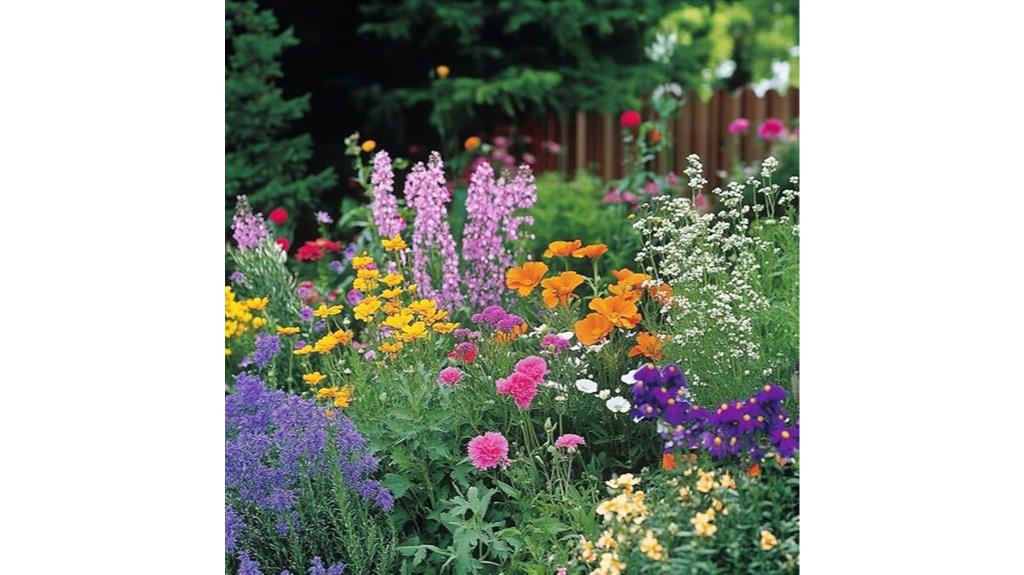
The Ferry-Morse Deer Resistant Mix Bulk Wildflower Seeds is an excellent choice for anyone looking to create a vibrant garden that keeps deer at bay. This 1-pound package offers around 530,000 to 570,000 seeds, covering up to 5,752 square feet, and is perfect for full sun zones 9a-10b. The wildflowers bloom from spring to fall, attracting pollinators and enhancing biodiversity. Easy to plant—just broadcast the seeds onto prepared soil and water regularly—I’ve found germination typically occurs within two weeks. Plus, it’s GMO-free and environmentally friendly, making it a reliable, low-maintenance way to add color and deter deer naturally.
Best For: gardeners seeking a low-maintenance, deer-resistant wildflower mix to attract pollinators and add vibrant color to full sun areas from spring to fall.
Pros:
- GMO-free and environmentally friendly, supporting sustainable gardening practices
- Covers a large area (up to 5,752 sq.ft.) with a high seed count (530,000–570,000 seeds)
- Easy to plant by simply broadcasting onto prepared soil and watering regularly
Cons:
- Germination may take 10-14 days, depending on soil conditions and planting method
- Requires re-seeding annually to maintain blooms year after year
- Height varies significantly (6-48 inches), which may not suit all garden designs
Proven Winners Bloomerang Dark Purple Lilac Plant

Proven Winners Bloomerang Dark Purple Lilac Plant stands out as an ideal choice for those seeking a deer-resistant shrub with continuous color and fragrance. Its compact size makes it perfect for small gardens, containers, and borders, while its fragrant, purple blooms provide visual and sensory appeal throughout spring and summer. This lilac is resilient and low-maintenance, thriving with minimal care and requiring little pruning. Its reblooming nature ensures a steady display of flowers, reducing the need for frequent replacements. Overall, it’s an excellent addition to any garden looking for beauty, fragrance, and deer resistance.
Best For: gardeners seeking a low-maintenance, fragrant, and deer-resistant shrub that provides continuous color in small garden spaces or containers.
Pros:
- Reblooms repeatedly in spring and summer for ongoing visual interest
- Fragrant purple blooms enhance sensory garden experiences
- Compact size ideal for small gardens, borders, or container planting
Cons:
- May require minimal pruning to maintain shape over time
- Blooming intensity can vary depending on local climate conditions
- Not suitable for very large landscape areas due to its compact size
Outsidepride Shasta Daisy Seeds, Deer & Drought Tolerant Perennials
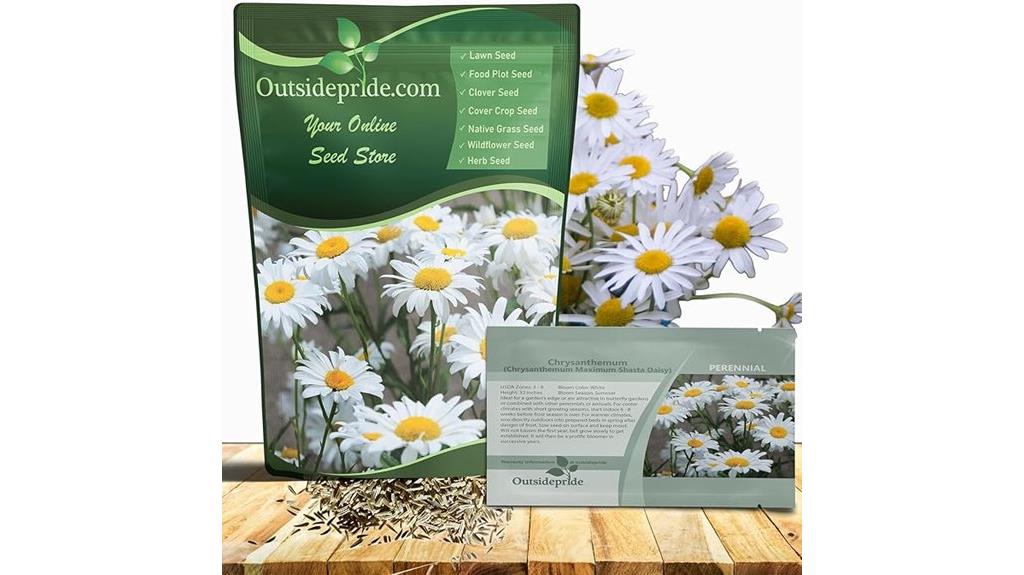
If you’re looking for a low-maintenance, deer-resistant perennial that adds vibrant color to your garden, Outsidepride Shasta Daisy Seeds are an excellent choice. These flowers produce tall, striking white blooms with yellow centers that can reach up to 32 inches, blooming from June to July. They thrive in full sun and well-drained soil across USDA Zones 3-9, tolerating drought and minimal watering. Perfect for wildflower gardens, borders, or cut flowers, they attract pollinators and require little upkeep. Sow the seeds in spring or fall, and enjoy long-lasting, vivid displays with minimal effort and deer resistance.
Best For: gardeners seeking low-maintenance, drought-tolerant perennials that attract pollinators and add vibrant white blooms to their landscape.
Pros:
- Vibrant, tall white flowers with yellow centers that bloom from June to July.
- Drought-tolerant, deer-resistant, and adaptable to USDA Zones 3-9.
- Low-maintenance, suitable for wildflower gardens, borders, and cut flower arrangements.
Cons:
- Seed germination may take time, requiring patience and proper planting conditions.
- Some customers have experienced variability in germination success.
- Plants may need dividing every 3-4 years to prevent overcrowding.
Allium Giganteum Seeds for Planting

Allium giganteum seeds are an excellent choice for gardeners seeking a striking, low-maintenance addition to their outdoor space that’s resistant to deer and rabbits. These seeds produce impressive, fragrant purple flowers from late spring to early summer, with blooms about the size of a softball. They thrive in full sun and well-drained, fertile sandy soil, requiring moderate watering. Once established, they’re drought-tolerant and easy to care for. Despite some concerns about germination, these seeds are known for their high success rate. They also attract pollinators, making them not only beautiful but beneficial for your garden’s ecosystem.
Best For: gardeners seeking a low-maintenance, pollinator-attracting ornamental onion that is resistant to deer and rabbits and thrives in full sun with well-drained soil.
Pros:
- Produces large, fragrant purple flowers that bloom from late spring to early summer
- Resistant to deer, rabbits, and drought once established
- High germination rates and easy to grow in suitable outdoor conditions
Cons:
- Some customers report poor germination and seeds not sprouting after several weeks
- Price matching is not guaranteed, and lower prices may be found online or offline
- Limited plant height (around 0.1 inches) may be less noticeable in some garden designs
Seed Needs Deer Resistant Wildflower Seed Mix
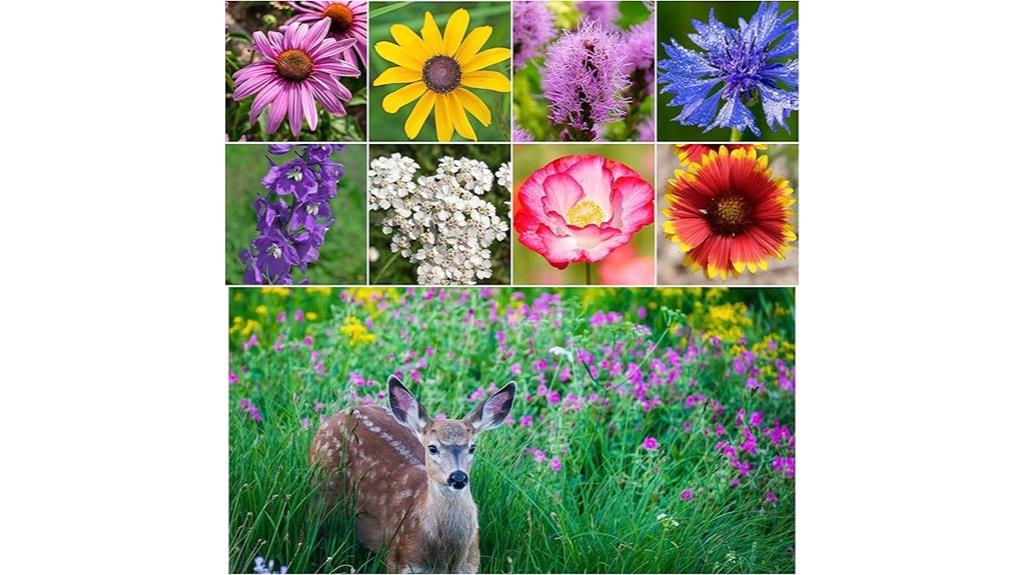
The Seed Needs Deer-Resistant Wildflower Seed Mix is an excellent choice for gardeners looking to enjoy vibrant blooms without worrying about deer munching on their plants. This 2-ounce packet contains over 30,000 pure, high-germination seeds from 16 perennial species like Black-Eyed Susan, Purple Coneflower, Columbine, and White Yarrow. It’s perfect for creating colorful, natural landscapes, attracting pollinators, and filling your garden with beauty. The mix includes both annual and perennial varieties, growing between 12 to 48 inches tall. Easy to plant and maintain, this seed blend offers a resilient, deer-resistant wildflower display for current and future growing seasons.
Best For: gardeners seeking a colorful, low-maintenance wildflower mix that is deer-resistant and attracts pollinators.
Pros:
- Contains over 30,000 high-germination seeds in a compact 2-ounce packet, ideal for large planting areas.
- Includes a diverse mix of 16 perennial wildflower species for vibrant, long-lasting blooms.
- Deer-resistant and non-GMO, making it suitable for natural landscapes and eco-friendly gardens.
Cons:
- May require specific soil conditions or additional care to ensure optimal germination and growth.
- The mix includes both annual and perennial species, so some plants may not return every year without reseeding.
- Limited to current and following growing seasons, so timing of planting is important for best results.
250 Aubrieta Seeds, Cascade Purple Flower Seeds, Perennial
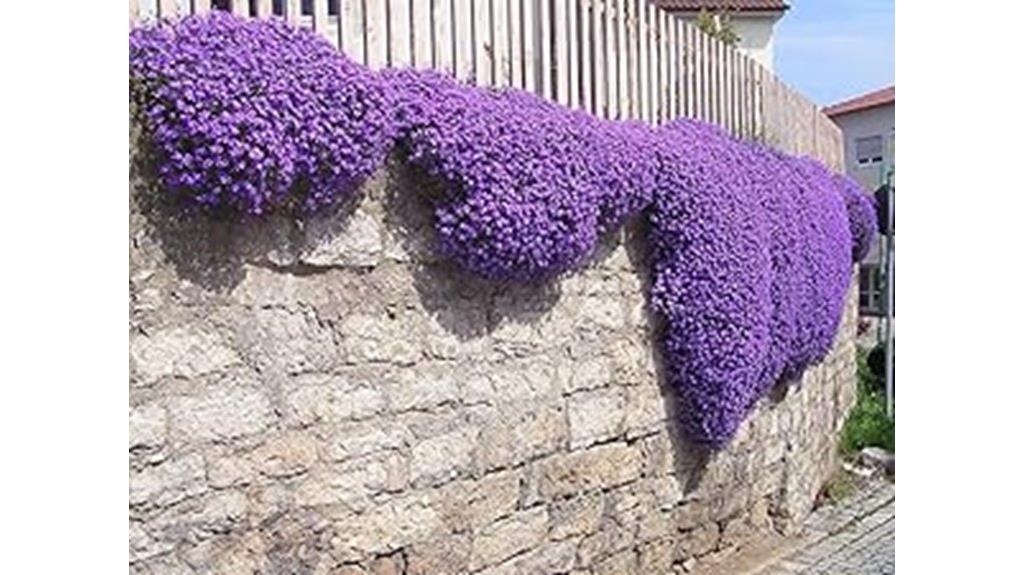
For gardeners looking to add vibrant color without worrying about deer nibbling on their plants, Aubrieta seeds offer an excellent solution. These perennial seeds produce stunning cascade-like purple flowers in spring and typically grow about 6 inches tall. They thrive in full sun or partial shade with sandy soil and moderate watering. Deer resistant and hardy in USDA zone 4, they’re ideal for temperate gardens. While germination can be inconsistent and may take 4-5 days using wet paper towel methods, many gardeners find success planting multiple seeds. Overall, these seeds provide a resilient, ornamental ground cover that enhances your garden’s beauty and deer resistance.
Best For: gardeners seeking vibrant, low-maintenance, deer-resistant ground cover to enhance outdoor spaces in temperate regions.
Pros:
- Produces beautiful cascade-like purple flowers in spring, adding vibrant color to gardens.
- Deer resistant and suitable for USDA zone 4, making it ideal for temperate outdoor environments.
- Easy to grow in full sun or partial shade with sandy soil and moderate watering needs.
Cons:
- Germination can be inconsistent, with some seeds failing to sprout despite proper care.
- Success may require planting multiple seeds and patience, as germination typically takes 4-5 days.
- Some gardeners prefer purchasing live plants for guaranteed flowering, as seed germination may be unreliable.
Outsidepride Deer Proof Wildflower Seed Mix, 1 lb

If you’re dealing with deer browsing your garden and want a colorful, low-maintenance solution, the Outsidepride Deer Proof Wildflower Seed Mix is an excellent choice. This 1 lb blend features drought-tolerant annuals and perennials like Lupine, Foxglove, Blanketflower, and Zinnia, which bloom all season long. It attracts butterflies and bees while remaining unappealing to deer and wildlife. Perfect for partial shade and various climates, these hardy plants thrive with minimal care, creating vibrant meadows that support biodiversity. Whether you’re planting scattered patches or dense stands, this mix adds beauty, color, and resilience to your landscape effortlessly.
Best For: gardeners seeking a deer-resistant, low-maintenance wildflower mix that attracts pollinators and thrives in drought-prone or shaded areas.
Pros:
- Attracts butterflies and bees, supporting local biodiversity
- Deer-proof and wildlife-unpalatable, reducing browsing damage
- Easy to plant, drought-tolerant, and requires minimal upkeep
Cons:
- May take time to establish fully before blooming profusely
- Growth height can vary, potentially not suitable for very low or very tall landscape needs
- Effectiveness can depend on proper soil preparation and seed coverage
Deer Resistant Wildflower Seeds (1 oz)
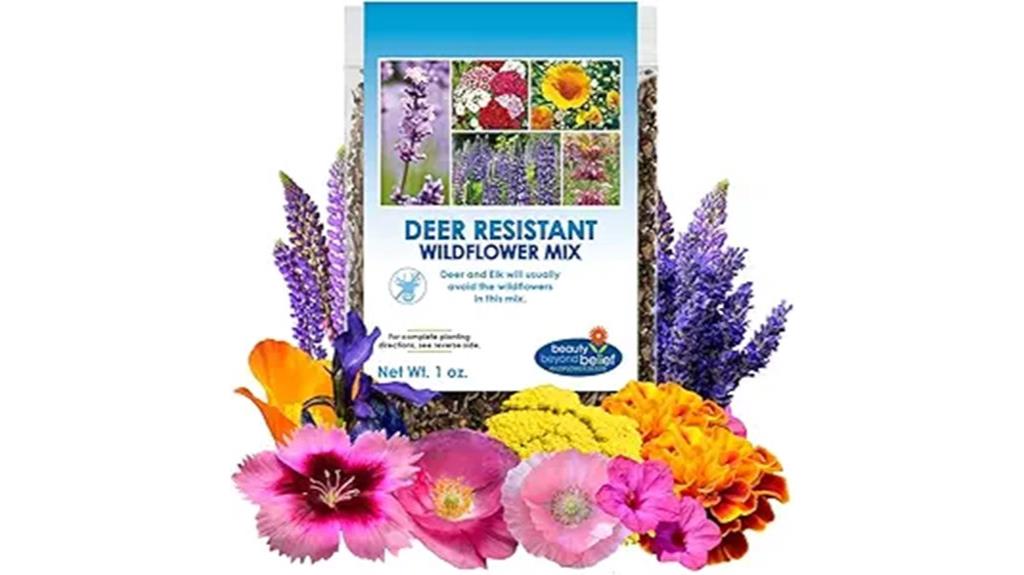
Deer-Resistant Wildflower Seeds (1 oz) are an excellent choice for gardeners seeking to enjoy vibrant blooms without worrying about deer browsing. Since 1985, this open-pollinated, non-GMO, organic mix has delivered high-quality seeds designed for full sun areas. Each packet covers about 100 sq. ft. and includes a variety of annuals and perennials that deer tend to avoid. Ideal for USDA zones 2-9, these seeds thrive in sandy soil with moderate watering. Customers appreciate the lush coverage and pollinator support, though results can vary based on planting conditions. Overall, it’s a reliable, eco-friendly option for a deer-resistant wildflower garden.
Best For: gardeners seeking deer-resistant, vibrant wildflower gardens that attract pollinators and require minimal maintenance in full sun and sandy soils.
Pros:
- Contains a high-quality, organic, non-GMO mix of annuals and perennials suitable for deer resistance
- Covers approximately 100 sq. ft. per packet, making it cost-effective for large areas
- Supports pollinators and enhances garden aesthetics with vibrant wildflowers
Cons:
- Results may vary depending on planting conditions and care, with some customers experiencing poor germination
- Limited seed quantity (1 oz.) may restrict planting options for larger landscapes
- Requires moderate watering and specific soil and sunlight conditions, which might not suit all environments
2 Gal. Obsession Nandina Shrub
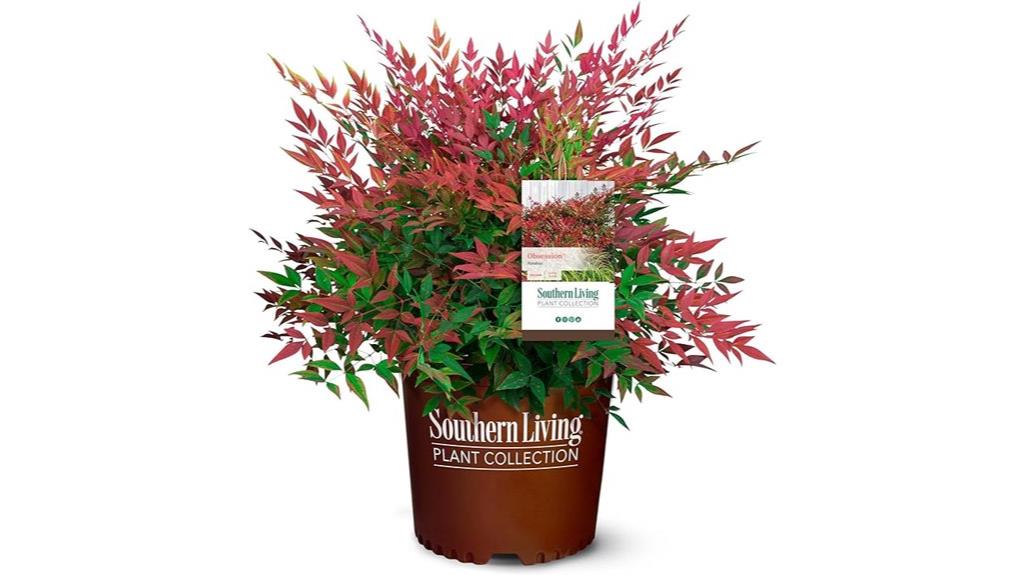
Looking for a low-maintenance shrub that adds vibrant color all year round? The Gal. Obsession Nandina Shrub is perfect. Its bright red foliage stands out, especially in winter, providing a striking visual element. Growing up to 48 inches tall, it’s versatile for gardens or containers. It thrives in full sun to part shade within USDA zones 6-10. With moderate watering, it stays healthy and colorful year-round. Customers love its easy care, vibrant appearance, and durable packaging. Whether used as a hedge or accent, this organic, evergreen shrub enhances any landscape while being deer resistant. It’s a beautiful, hassle-free addition to your garden.
Best For: gardeners and landscape enthusiasts seeking a vibrant, low-maintenance evergreen shrub that adds year-round color and visual interest to gardens or containers in USDA zones 6-10.
Pros:
- Bright red foliage provides striking color, especially in winter
- Easy to care for with moderate watering and adaptable sunlight requirements
- Well-packaged, healthy, and full, often arriving larger than expected
Cons:
- May require patience to achieve full, taller growth as it matures
- Some customers might desire more dense or fuller foliage earlier in growth
- Limited to USDA zones 6-10, not suitable for colder or hotter regions
Factors to Consider When Choosing Deer‑Resistant Plants
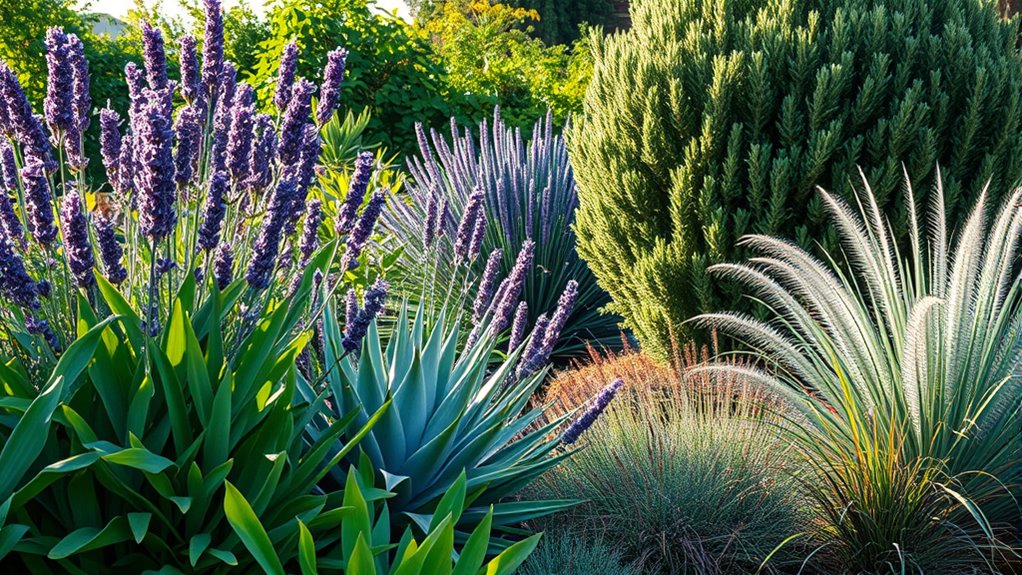
When selecting deer-resistant plants, I consider how local deer tend to behave and what they’re likely to avoid. I also pay attention to whether a plant suits my climate, soil, and the size or shape that fits my garden. Additionally, I think about blooming periods to make certain of continuous interest without attracting unwanted attention.
Local Deer Behavior
Understanding local deer behavior is essential when selecting plants that are truly deer-resistant. Deer feeding habits differ by region, with some areas showing a preference for specific plants while avoiding others. Over time, local deer populations may develop preferences based on available food sources, which can change their resistance to certain plants. Deer tend to avoid toxic, bitter, or strongly scented plants, but these tendencies vary depending on regional flora and their exposure to these plants. Seasonal food scarcity can also influence their foraging, causing them to sample less preferred plants more often. By observing local deer activity and their preferred foraging times, you can better identify which plants are naturally less appealing and more likely to remain untouched in your garden.
Climate Compatibility
Choosing deer-resistant plants that will thrive in your garden starts with selecting varieties compatible with your climate. I always check that the plant’s hardiness zone matches my local conditions, since deer-resistant plants are often zone-specific. It’s vital to choose plants suited to your area’s temperature range—whether hot, cold, or moderate—to ensure they survive and resist deer browsing. I also pay attention to moisture levels; in dry regions, drought-tolerant plants work best, while wetter areas benefit from water-loving varieties. Matching the plant’s native habitat preferences with my soil type and exposure—full sun, partial shade, or full shade—is essential. Keep in mind, regional deer habits vary, so what’s resistant here might not be the same elsewhere.
Soil Preferences
Soil preferences play a crucial role in guaranteeing your deer-resistant plants thrive. Most of these plants prefer well-drained soils, like sandy or loamy types, which help prevent root rot and support healthy growth. They tend to do best in neutral to slightly acidic soils, with a pH between 6.0 and 7.0, optimizing nutrient absorption. Remarkably, some species tolerate poor soil conditions, such as rocky or nutrient-deficient soils, which means less need for soil amendments. Proper drainage is critical—overly moist or clay-heavy soils can lead to disease and hinder establishment. Adjusting soil pH and improving drainage can notably boost your success when planting deer-resistant varieties in different garden environments. Focusing on soil needs ensures healthier plants and a more resilient garden.
Plant Size & Shape
When selecting deer-resistant plants, considering their size and shape helps guarantee they fit well within your garden and serve your landscape goals. I always check the mature height and spread to make sure plants won’t overcrowd other species or block pathways. If I need ground cover or border plants, I look for compact or low-growing varieties that won’t obstruct views. For vertical interest or screening, I choose upright, columnar, or shrub-like forms, adjusting the height accordingly. I also pay attention to shapes—spiky or dense foliage often deters deer and adds texture. Matching the plant’s form with my garden design helps create a balanced landscape, ensuring the plants are both attractive and functional while enhancing deer resistance.
Blooming Periods
Considering the blooming periods of deer-resistant plants is essential for maintaining vibrant and continuous garden interest throughout the seasons. Many of these plants bloom from late spring to early summer or from midsummer to fall, providing consistent color and visual appeal. Some annuals bloom quickly in spring and rebloom sporadically, offering frequent bursts of color that keep the garden lively. Planning overlapping flowering times allows for a continuous display and reduces gaps in visual interest. Understanding each plant’s bloom cycle helps in selecting varieties that match your desired aesthetic and seasonal needs. By choosing plants with staggered or extended blooming periods, you can create a dynamic, attractive garden that stays colorful and inviting year-round, even with deer resistance in mind.
Maintenance Needs
Choosing deer-resistant plants that require minimal maintenance can save you time and effort in your garden. Once established, many of these plants don’t need frequent pruning or pest control, making them easier to care for. They’re often drought-tolerant, thriving with less watering, which reduces ongoing effort. Opting for native and hardy species can further lower maintenance since they’re better adapted to local conditions and less prone to diseases and pests. Some deer-resistant plants grow slowly or need fertilization only occasionally, simplifying care routines. Proper planting techniques, like soil preparation and mulching, also boost plant health and decrease the need for regular upkeep. Overall, selecting low-maintenance, deer-resistant plants helps keep your garden beautiful with less work.
Landscape Integration
Integrating deer-resistant plants into your landscape requires careful attention to how they complement existing elements. I recommend selecting plants that blend seamlessly with pathways, borders, and focal points to create a cohesive look. Pay attention to the color schemes and textures of nearby non-resistant plants, choosing deer-resistant options that enhance visual harmony. It’s important to contemplate the mature size and shape of these plants to maintain proportion and prevent overcrowding. I also find layering works well—combining ground covers, mid-height shrubs, and taller specimens adds depth and interest. Additionally, using natural barriers, elevation changes, or strategic placement alongside deer-resistant plants can reinforce deterrence and improve the overall garden cohesion. Thoughtful integration ensures your garden remains beautiful and functional.
Pest & Disease Resistance
When selecting deer-resistant plants, it’s important to recognize that many of these species naturally defend themselves with features like thorns, tough leaves, or aromatic compounds, which also help them resist common pests and diseases. These natural defenses make them less appealing to insects and less susceptible to infections like mold, blight, or fungal issues. Choosing plants with proven pest and disease resistance means less need for chemical treatments, promoting a healthier garden environment. Many deer-resistant varieties are adapted to withstand typical plant problems, ensuring they stay durable and attractive over time. Additionally, resistant plants can help prevent the spread of infections to neighboring plants, reducing overall garden maintenance. This combination of deer resistance and pest/disease resilience makes these plants a smart choice for a thriving, low-maintenance landscape.
Frequently Asked Questions
Can Deer Develop Resistance to Certain Plants Over Time?
Yes, deer can develop resistance to certain plants over time. When they repeatedly browse on specific plants, they may become less deterred, especially if alternative food sources are scarce. That’s why I recommend mixing up your garden with a variety of deer-resistant plants and changing your plant choices periodically. It helps keep deer from getting used to your garden’s defenses, maintaining its safety and beauty.
Are Deer-Resistant Plants Suitable for All Soil Types?
Think of your garden as a symphony, where each plant plays its part. Yes, deer-resistant plants are generally suitable for most soil types, but their success depends on matching the right plant to your soil’s specific conditions. I recommend testing your soil first and choosing plants accordingly. While some varieties are adaptable, knowing your soil’s pH and drainage helps guarantee they thrive and keep deer at bay.
How Often Should I Water Deer-Resistant Plants for Optimal Growth?
I usually water my deer-resistant plants once a week, providing about an inch of water to keep the soil consistently moist but not soggy. During hot, dry spells, I increase watering frequency to twice a week. I also check the soil moisture regularly—if it feels dry several inches down, it’s time to water again. Proper watering encourages healthy growth and helps these plants thrive in your garden.
Do Deer-Resistant Plants Require Special Fertilization?
Think of your plants as a finely tuned orchestra—they thrive with just the right nutrients. Deer-resistant plants generally don’t require special fertilization, but I recommend using a balanced, slow-release fertilizer in early spring to support healthy growth. Over-fertilizing can make them more appealing to deer, so I keep it moderate. Regular feeding helps keep your garden vibrant and resilient without attracting unwanted guests.
Are There Any Deer-Resistant Plants That Attract Beneficial Insects?
Yes, many deer-resistant plants attract beneficial insects. I’ve found that plants like yarrow, lavender, and fennel draw pollinators such as bees and butterflies while deterring deer. These plants not only protect your garden but also boost biodiversity. I recommend planting a mix of these to create a vibrant, insect-friendly environment that stays safe from deer damage. It’s a win-win for your garden’s health and beauty.
Conclusion
Remember, a wise gardener knows that “an ounce of prevention is worth a pound of cure.” By choosing these deer-resistant plants, you can enjoy a beautiful, worry-free garden. It’s all about selecting the right plants that stand up to deer’s curiosity, saving you time and frustration. With a little planning, your garden will flourish, remaining vibrant and safe. Happy gardening—your patience truly pays off!
